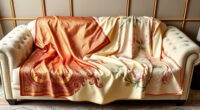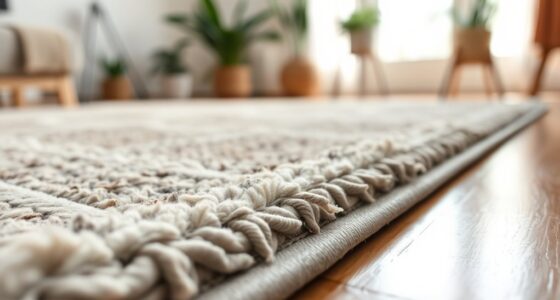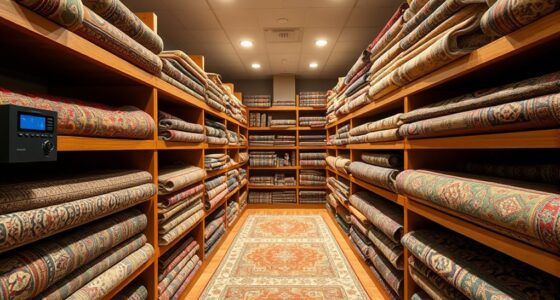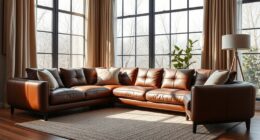During humid summers and monsoon seasons, you should regularly clean your rugs, vacuuming at least twice a week, and guarantee they dry completely using fans or air circulation, avoiding direct sunlight. Use dehumidifiers and keep your spaces well-ventilated to reduce moisture buildup. Consider choosing moisture-resistant or synthetic rugs, and store them properly during heavy rains. If you stay attentive to signs of mold and mildew, you’ll keep your rugs in good shape; uncover more tips to protect your rugs effectively.
Key Takeaways
- Use moisture-resistant rugs and materials like nylon or treated natural fibers to prevent mold and mildew.
- Ensure proper cleaning, thorough drying, and good air circulation after spills or cleaning to avoid dampness.
- Utilize dehumidifiers and fans to maintain low humidity levels and promote airflow around rugs.
- Store rugs in dry, ventilated, and elevated spaces, using breathable covers or airtight containers for long-term protection.
- Regularly inspect and promptly clean rugs to detect and prevent mold, pests, and fiber deterioration during monsoon seasons.
Understanding the Impact of Humidity on Rugs
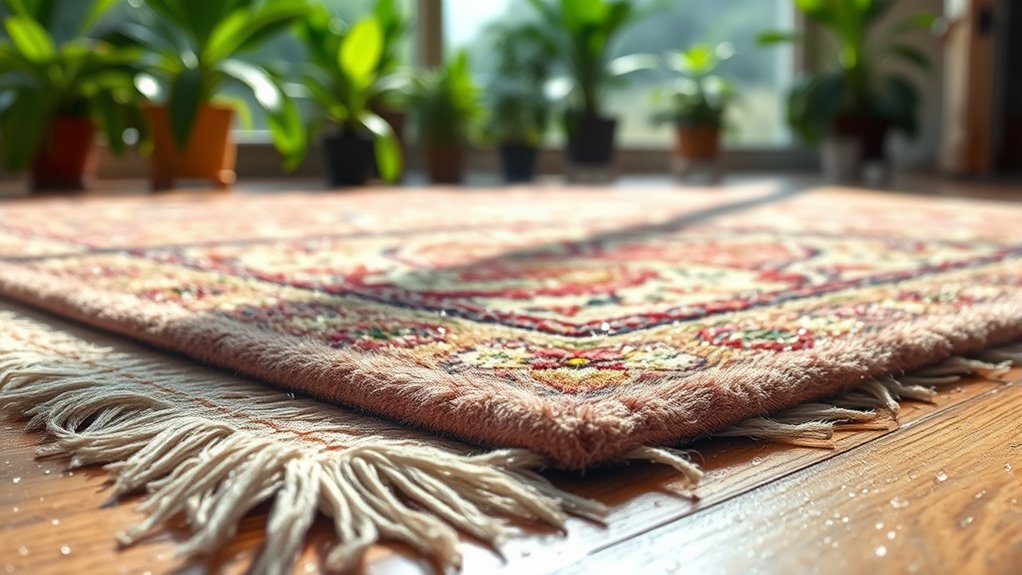
During the monsoon season, high humidity levels can considerably affect your rugs. Humidity effects lead to increased moisture absorption, which can cause fibers to weaken over time. Excess moisture promotes mold and mildew growth, accelerating rug deterioration and creating unpleasant odors. When humidity levels rise, your rug’s fibers can become soft and fragile, making them more prone to tearing or fraying. Additionally, dampness can attract pests like moths and carpet beetles, further damaging your investment. Understanding these humidity effects helps you recognize the importance of proper care during rainy months. Without intervention, your rug’s lifespan diminishes, and its appearance can suffer. Being aware of how humidity impacts your rugs allows you to take proactive steps to protect them from the damaging effects of moisture. Effective humidity control is crucial to maintaining your rugs’ quality and longevity during humid seasons.
Regular Cleaning and Vacuuming for Rug Care
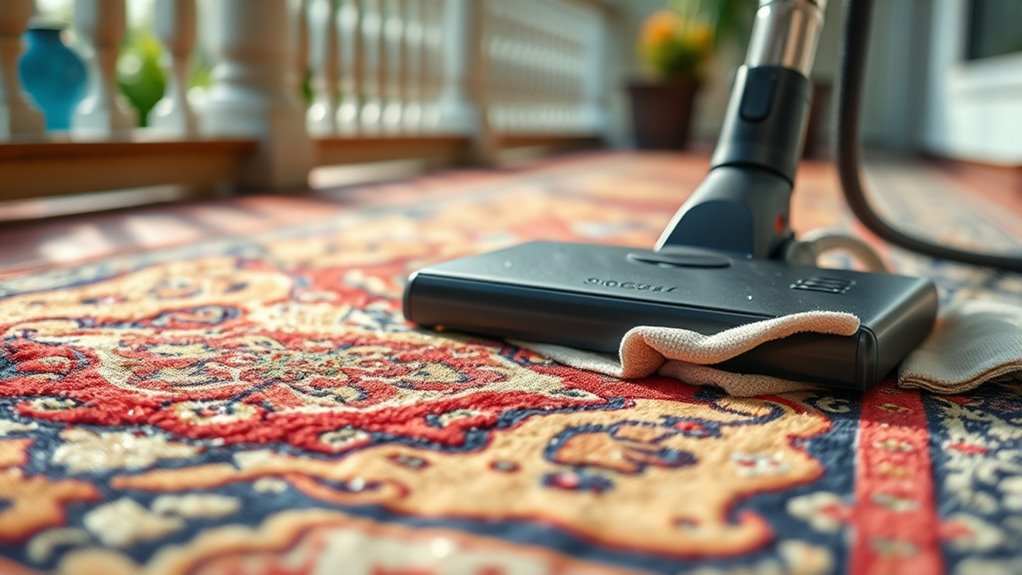
Regular cleaning and vacuuming are essential steps in maintaining your rug’s appearance and longevity, especially during the monsoon season. You should establish a consistent cleaning schedule to prevent dirt and moisture buildup. Vacuum at least twice a week, focusing on high-traffic areas, to remove surface dust and prevent dirt from settling deep into fibers. This routine helps keep your rug fresh and reduces the risk of mold or mildew. Regularly checking the air quality indicators of your home can help you determine if additional cleaning or dehumidifying measures are necessary to protect your rug from excess humidity. Imagine a vacuum gliding smoothly over plush fibers, lifting dirt from every corner. Picture dust and damp debris being sucked away, leaving your rug clean and dry. Remember, a well-maintained vacuum frequency and regular cleaning are your best defenses against the humid season’s effects. Keep your rug looking vibrant and safe with these simple, effective habits.
Proper Drying Techniques After Cleaning or Spills
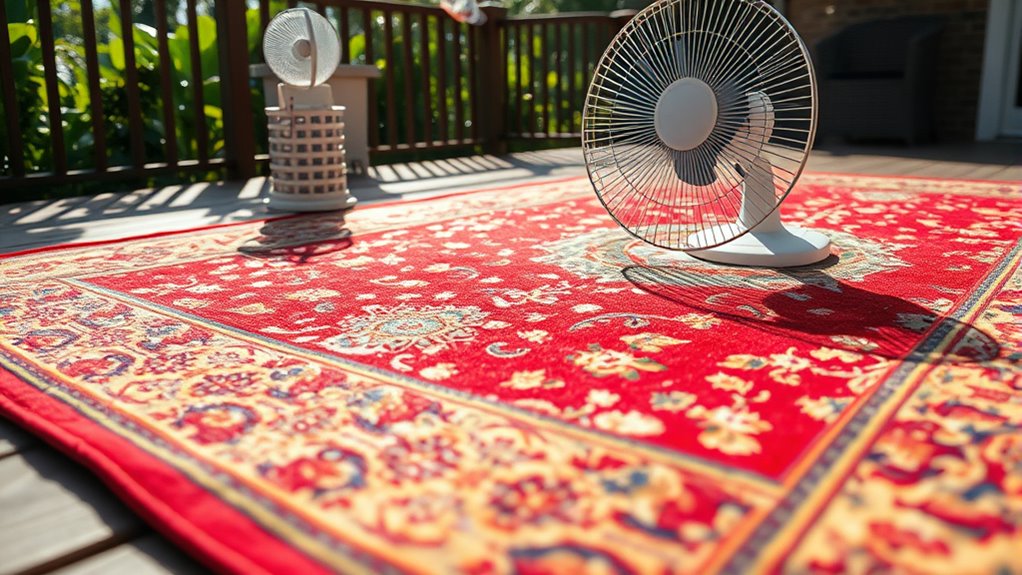
After cleaning or spills, make sure to dry your rugs thoroughly to prevent mold and odors. Good air circulation speeds up the drying process and helps keep your rug fresh. Avoid exposing your rug to direct sunlight, as it can cause fading and damage over time. Using a fan or dehumidifier can further enhance proper drying techniques for your rugs.
Air Circulation Importance
Proper air circulation is essential for effective drying after cleaning or spills, as it helps moisture evaporate quickly and prevents mold growth. Ensuring good airflow enhancement speeds up the drying process and keeps your rug fresh. To improve ventilation strategies, position fans nearby or open windows to promote continuous airflow. This reduces humidity levels and discourages mold formation. Visualize your space with:
- A gentle breeze flowing across the rug, whisking away dampness
- Fans oscillating steadily, creating consistent air movement
- Open windows inviting fresh air and reducing stagnant moisture
- Proper drying techniques play a crucial role in maintaining rug longevity and preventing damage.
Avoid Sunlight Exposure
Have you ever noticed how direct sunlight can harm your rug’s fibers? Sunlight damage accelerates wear and causes color fading, making your rug look dull over time. After cleaning or spills, it’s tempting to dry your rug in the sun, but this can worsen the damage. Instead, opt for drying in a shaded area with good airflow. Avoid direct sunlight to preserve the vibrancy of your rug’s colors and prevent fiber deterioration. If you must dry indoors, use fans or open windows to encourage air circulation without exposing the rug to harsh sunlight. Proper drying techniques are essential during humid monsoon seasons to prevent further damage and maintain your rug’s appearance and longevity. Additionally, data analytics can help monitor and predict the impact of environmental conditions on your rugs over time.
Using Dehumidifiers and Air Circulation to Reduce Moisture

Using dehumidifiers and ensuring proper air circulation are effective ways to reduce excess moisture during the monsoon season. Place your dehumidifier in a central spot, away from walls and rugs, to maximize airflow and moisture removal. Adjust air circulation strategies by opening windows or using fans to create a gentle breeze that helps evaporate dampness. Visualize the air moving freely around your space, carrying away moisture and preventing mold growth. Keep these points in mind:
- The dehumidifier pulls damp air into its coils, drying the environment quickly.
- Strategically placed fans direct air across rugs and walls for even drying.
- Cross-ventilation encourages fresh air exchange, reducing humidity buildup.
- Understanding the importance of air circulation can significantly improve the effectiveness of moisture control.
Together, these methods help maintain a dry, mold-free environment, protecting your rugs from damage.
Choosing the Right Rug Materials for Humid Climates
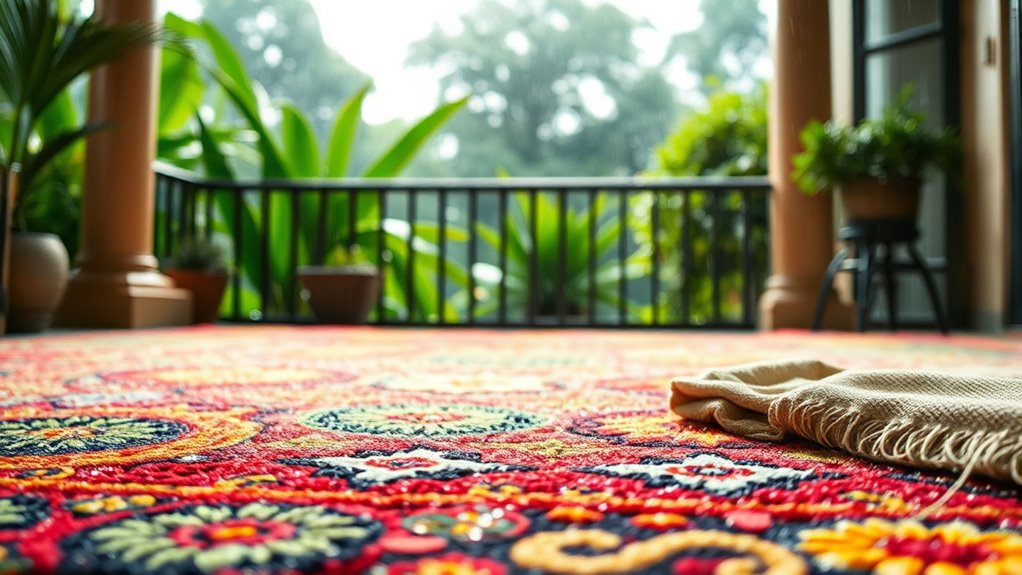
When selecting rugs for humid climates, you should consider materials that stand up to moisture and mold. Natural fibers like wool can be durable but may require extra care, while synthetic options often resist mold and mildew better. Choosing the right material helps keep your space clean and free from damage during the monsoon season. Additionally, proper installation and maintenance are vital to prevent moisture buildup and ensure the longevity of your rugs.
Natural Fiber Durability
Choosing the right rug materials for humid climates requires understanding how natural fibers withstand moisture. Natural fiber durability varies, affecting how well your rug handles humidity and frequent cleaning. Some fibers like jute and coir tend to absorb moisture quickly, leading to mold or mildew if not properly maintained. Others, such as wool, have better resilience when properly cared for. When selecting materials, picture:
- Thick, tightly woven fibers that resist moisture penetration
- Rugs with natural oils that repel dampness
- Textures that hide dirt and prevent mold buildup
- Considering the water absorption properties of different fibers can help you choose more durable and mold-resistant options.
Synthetic Material Benefits
Are synthetic materials a smart choice for rugs in humid climates? Absolutely. Synthetic fibers like nylon, polyester, and polypropylene offer excellent synthetic durability, making them resistant to wear and tear caused by moisture and humidity. They’re also highly stain resistant, which is vital during monsoon seasons when spills and mud are common. These materials don’t absorb water easily, preventing mold and mildew growth that can damage natural fibers. Plus, they’re easy to clean and maintain, saving you time and effort. Synthetic rugs stay vibrant longer since they resist fading from humidity and sunlight. Overall, choosing synthetic materials guarantees your rug remains resilient, attractive, and low-maintenance throughout the humid summer months.
Mold and Mildew Resistance
Synthetic materials not only offer durability and stain resistance but also excel at resisting mold and mildew growth in humid environments. To prevent issues, look for rugs with antimicrobial coatings that inhibit mold spores and bacteria. Many options now feature eco-friendly treatments, reducing environmental impact while keeping your rug fresh. These treatments create a protective barrier that discourages moisture buildup, which is essential during monsoon seasons. Imagine walking barefoot on a rug that stays clean and dry, free from musty odors. Visualize the following:
- A rug with embedded antimicrobial agents that actively fight mold growth
- Eco friendly treatments that safeguard both your health and the environment
- A moisture-resistant surface that stays pristine despite high humidity
Choosing the right materials helps you maintain a clean, healthy space during humid summers. Proper rug materials are crucial for long-term protection and can significantly extend the lifespan of your investment.
Applying Protective Measures and Treatments
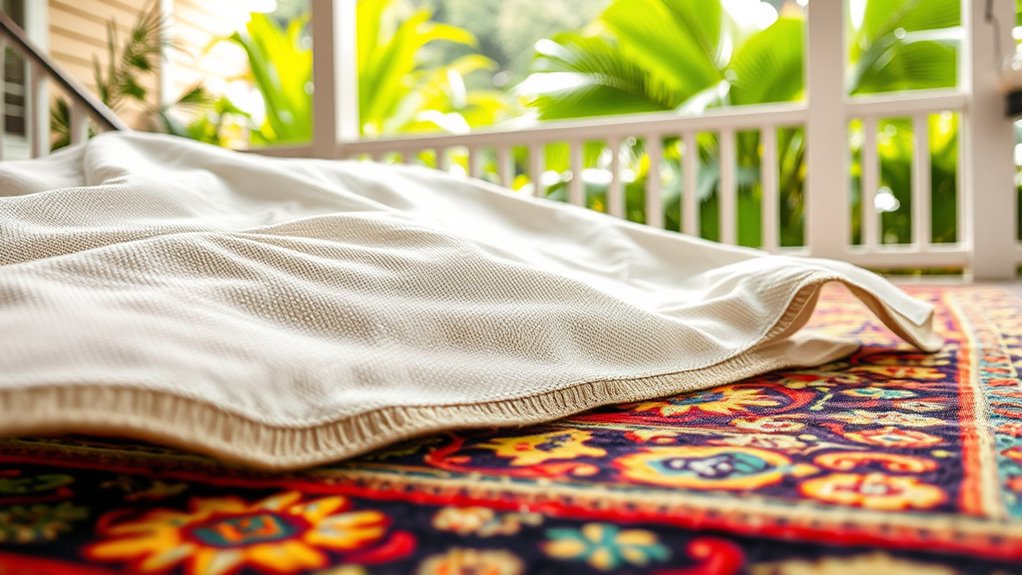
During the monsoon season, applying protective measures and treatments is essential to safeguard your rugs from moisture damage. Use protective coatings to create a barrier against humidity and prevent mold growth. Anti mildew sprays are effective in stopping mold spores before they settle. Regularly treat your rugs with these products to maintain their integrity. Here’s a quick comparison:
| Protective Measures | Benefits |
|---|---|
| Protective coatings | Create moisture barriers, extend rug life |
| Anti mildew sprays | Prevent mold and mildew formation |
| Proper ventilation | Reduce humidity levels |
In addition, ensuring proper workspace organization can help in maintaining a clean and healthy environment for your rugs.
Storing Rugs Safely During Heavy Rains
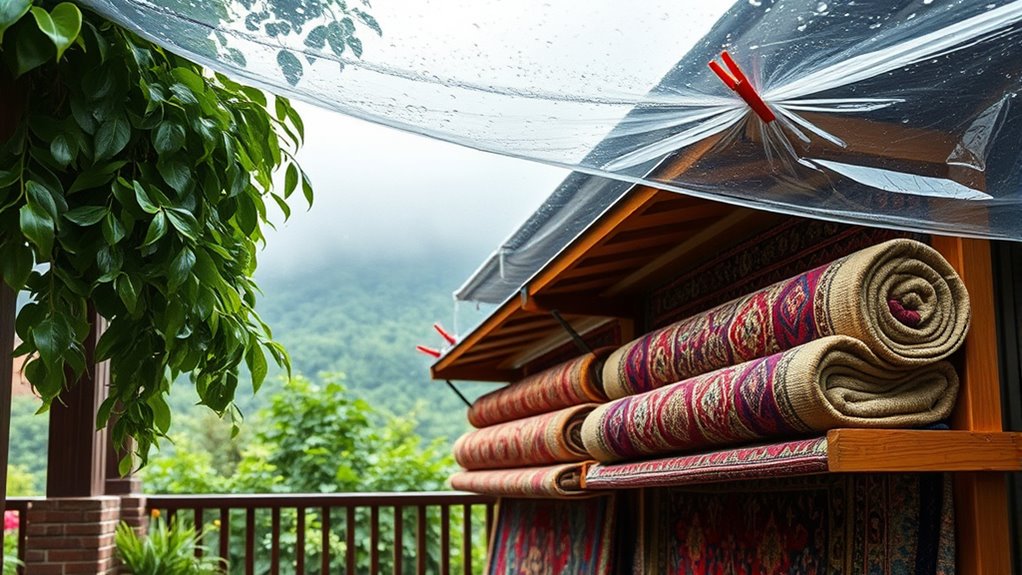
When heavy rains are forecasted, it’s crucial to store your rugs properly to prevent water damage. Start by cleaning and thoroughly drying your rugs before storage. Choose a cool, dry, well-ventilated space for seasonal storage, away from direct sunlight and humidity. Elevate your rugs on shelves or pallets to prevent contact with damp floors. Use pest prevention measures like airtight containers or plastic wraps to keep pests out. Visualize your rug resting on a raised platform, protected by a breathable cover, in a storage area free from moisture and pests. Protecting your rugs during heavy rains ensures they stay in good condition for years to come. Proper storage minimizes mold risk and keeps pests at bay during the monsoon season.
Monitoring and Addressing Signs of Mold or Mildew
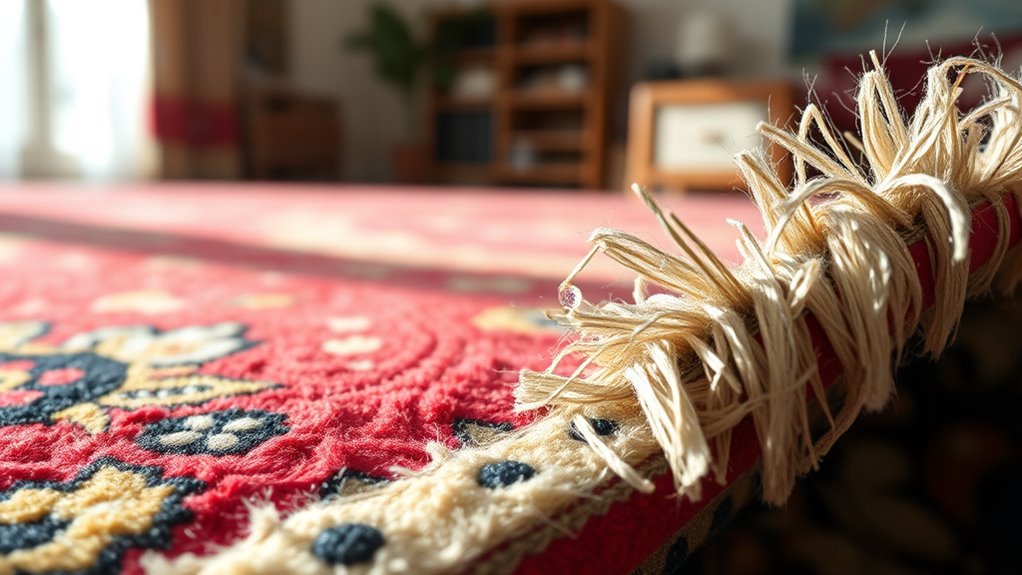
Since mold and mildew thrive in damp, poorly ventilated areas, it’s essential to regularly inspect your stored rugs for any signs of growth. Spotting mold early allows you to act quickly and prevent further damage. Look for discoloration, fuzzy patches, or a musty smell, especially in corners or folds. If you notice any mold, carefully clean the affected area with a mixture of vinegar and water or a commercial mold remover. Ensure your rugs are thoroughly dried before storage to prevent mildew from developing. Improving ventilation and using dehumidifiers can also help reduce humidity levels, making it harder for mold to grow. Regular monitoring and prompt action are your best defenses against mold and mildew, keeping your rugs fresh and protected during humid summers.
Frequently Asked Questions
How Often Should I Inspect My Rugs During Monsoon Season?
You should inspect your rugs at least once a week during the monsoon season. Rug inspection helps you catch any signs of moisture or mold early. Keep humidity monitoring handy to track the moisture levels in your home. If you notice increased humidity or dampness, increase inspections and dry out your rugs promptly. Regular checks help maintain your rugs’ condition and prevent long-term damage caused by humidity.
Can Natural Remedies Prevent Mold Growth on Rugs?
Natural solutions and DIY treatments can help prevent mold growth on your rugs. You can regularly sprinkle baking soda to absorb moisture, or use a mixture of vinegar and water as a natural disinfectant. Ensuring proper ventilation and sunlight exposure also helps keep your rugs dry and mold-free. While these natural remedies are effective, consistent inspection and cleaning are essential to maintain your rug’s health during humid weather.
Are There Specific Colors or Patterns That Hide Humidity Damage Better?
Oh, who would’ve thought that choosing the right colors or patterns could hide humidity damage? You might think bold, vibrant designs or intricate patterns are best, but they actually do a better job at color camouflage and pattern concealment of water stains or mold spots. Subtle shades and busy patterns can help disguise early signs of moisture issues, giving you a little extra time before damage becomes obvious—making your rug’s imperfections almost invisible.
What Are the Best Indoor Plants to Improve Air Quality Around Rugs?
You ask about the best indoor plants to improve air quality around rugs. Opt for air purifying plants like snake plants, pothos, and peace lilies, which help filter toxins and boost freshness. Choose humidity tolerant greenery such as ferns and spider plants, as they thrive in humid environments. These plants not only enhance air quality but also help manage moisture levels, protecting your rugs during humid summers.
How Can I Prevent Pest Infestations in Damp Rug Environments?
Think of your rug as a garden that needs tending. To prevent pest infestations, practice pest prevention by regularly inspecting for signs of unwelcome visitors. Manage your damp environment by ensuring proper ventilation and using dehumidifiers. Keep the rug dry and clean, and consider natural repellents like cedar or essential oils. These steps help create an inhospitable space for pests, safeguarding your rug’s beauty and integrity.
Conclusion
Don’t let humidity ruin your rugs this monsoon. With regular cleaning, proper drying, and smart storage, you can keep them looking fresh and mold-free. Some might think it’s too much effort, but taking these simple steps safeguards your investment and ensures a cozy, beautiful home. Remember, a little extra care now saves you time and money later. Keep your rugs safe, and enjoy a comfortable, damp-free living space all season long.

